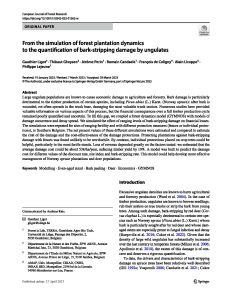
Abstract:
Large ungulate populations are known to cause economic damage to agriculture and forestry. Bark damage is particularly detrimental to the timber production of certain species, including Picea abies (L.) Karst. (Norway spruce): after bark is wounded, rot often spreads in the trunk base, damaging the most valuable trunk section. Numerous studies have provided valuable information on various aspects of this process, but the financial consequences over a full timber production cycle remained poorly quantified and uncertain. To fill this gap, we coupled a forest dynamics model (GYMNOS) with models of damage occurrence and decay spread. We simulated the effect of ranging levels of bark-stripping damage on financial losses.
The simulations were repeated for sites of ranging fertility and with different protection measures (fences or individual protections), in Southern Belgium. The net present values of these different simulations were estimated and compared to estimate the cost of the damage and the cost-effectiveness of the damage protections. Protecting plantations against bark-stripping damage with fences was found unlikely to be worthwhile. By contrast, individual protections placed on crop trees could be helpful, particularly in the most fertile stands. Loss of revenue depended greatly on the factors tested: we estimated that the average damage cost could be about 53€/ha/year, reducing timber yield by 19%. A model was built to predict the damage cost for different values of the discount rate, site index and bark-stripping rate. This model could help develop more effective management of Norway spruce plantations and deer populations.
Consultez la notice complète de l’article sur ORBi
